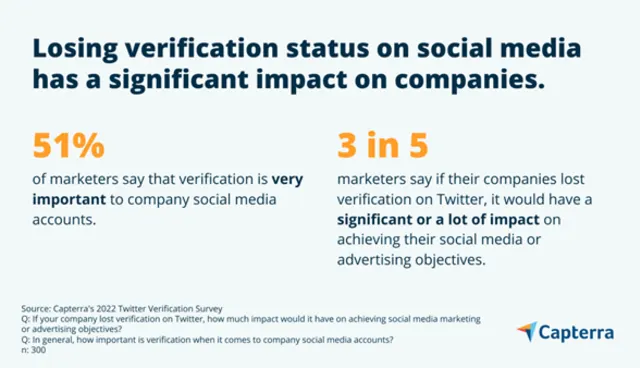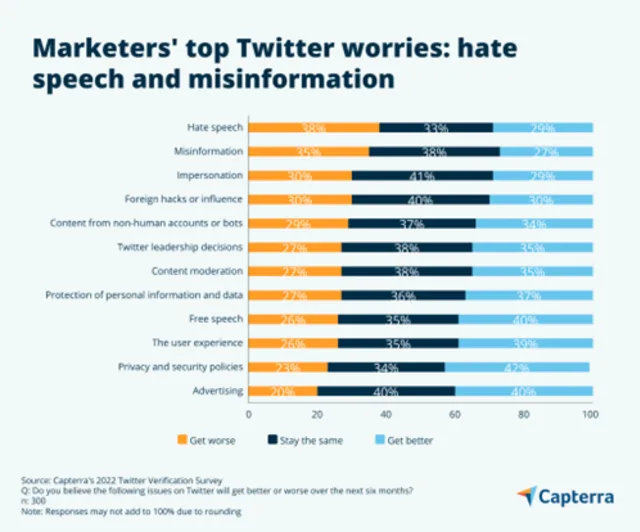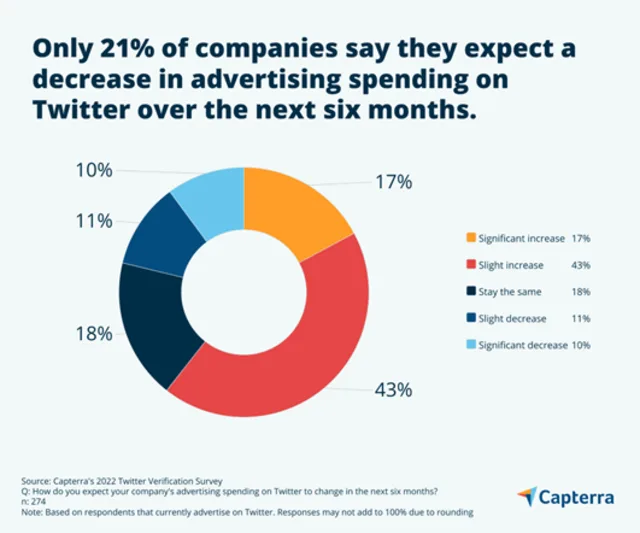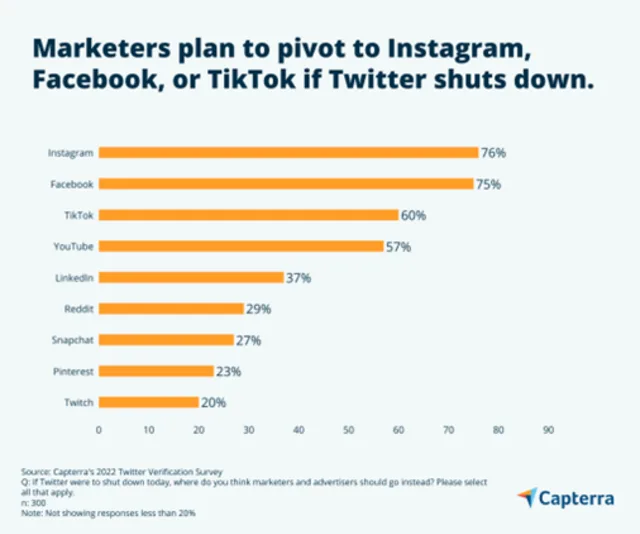With Twitter re-launching its controversial $8 verification program today (which now costs $11 for some users), what impact will that have on the platform, and how are brands feeling about the changes to its verification program, which will now see them get a gold tick instead of a blue one?
The team from Capterra sought to find out, surveying 300 US marketing and advertising professionals to get their thoughts on Elon’s paid verification program, how they’re approaching Twitter ads, the changes to verification status, and more.
You can check out Capterra’s full survey report here, but in this post, we’ll look at some of the key notes.
First off, according to Capterra’s data, 53% of brands say that they’re unlikely to pay $7.99 a month for verification on Twitter.
Now, a lot of that will depend on exactly how Twitter goes about this, and what sort of broader momentum the program sees. At present, brands that already have a blue checkmark will now get a gold one instead, to mitigate the risks of impersonation, and at some stage, they’ll likely have to pay $8 per month to keep that gold tick.
But we don’t know when the deadline for this will be, and if the new verification program sees massive take-up, which then prompts other brands to buy-in, there could be increased momentum for all brands to pay-up, in order to keep the indicator of authority, and trust, in the app.
But right now, just over half of brands don’t see the value in paying for a checkmark.
Indeed, respondents indicated that they’d be more willing to pay for better promotion opportunities, better user targeting, and improved security in the app over verification.
That said, just over half of brands also indicated that they believe verification does serve an important purpose.

When you combine the two data points, you can see a world where more brands do indeed start paying $8 per month to keep their checkmark in the app.
Again, it all depends on broader take-up – if a lot of users sign-on to the program, and it becomes an accepted thing, the overall momentum could also see more brands getting on-board. But it depends on general adoption, and also the amount of time that Twitter gives brands before it takes their checkmark away, if they don’t sign-up.
In terms of overall risk on the platform, given Musk’s stated passion for allowing more ‘free speech’ in the app, nearly 2 out of 3 current Twitter advertisers say that advertising on the platform is risky for their brand right now.
Among the main concerns are increased incidences of hate speech, as well as misinformation, and impersonation – with the latter being a key problem with the initial launch of Twitter’s updated verification plan.

Again, Twitter’s updated verification program seems to have addressed a lot of the impersonation concerns, at least from a brand perspective. But clearly, there are still some concerns among the business community.
Hate speech and misinformation have also, reportedly, increased since Elon took over at the app – though Twitter itself says that hate speech, overall, is on the decline.
Still, as Elon brings back thousands of previously banned users, and touts COVID theories from his own account, you can understand why some brands are hesitant about the app at this stage.
Still, these concerns, at least right now, don’t appear to be having a big impact on overall ad spend habits.

Less than a quarter of participants indicated that they’re looking to reduce Twitter ad spend, while 31% of brands have opted to monitor the situation, rather than suspending current ad campaigns.
As with most Twitter elements, it’s a bit of a ‘wait and see’, with the impacts of Musk’s changes set to happen over time, making it harder to judge the right approach just yet.
And with Elon also proclaiming record high usage, you can see why some advertisers are facing a dilemma, which can only be answered by seeing what comes next at the app.
But they are also preparing for the worst:

As you can see in this chart, approximately 3 in 4 respondents believe marketers will move to other top social media platforms such as Instagram (76%), Facebook (75%), and TikTok (60%) if Twitter shuts down.
Which still seems unlikely. I mean, Elon is clearly taking some risks, which is pretty much how he operates – Musk seems willing to take on far bigger risk than most other business owners would dare, which, thus far, has helped him achieve much bigger success as a result.
But it could also fall flat.
The total collapse of Twitter would take a massive shift, and I don’t think it’ll get that far. But if it does come to that, Instagram looks like the biggest beneficiary, based on these stats, followed by Facebook and TikTok.
These are some interesting notes on how businesses view the current state of Twitter, and Elon’s reformation of the app. And while, again, it’s mostly a ‘wait and see’ proposition, the pulse of brands right now is that there is a level of hesitancy, which really could go either way.
It all depends on what comes next.
NOTE: Elon Musk has re-stated, once again that ‘legacy’ blue checkmarks will be phased out ‘in a few months’.
In a few months, we will remove all legacy blue checks. The way in which they were given out was corrupt and nonsensical.
— Elon Musk (@elonmusk) December 12, 2022
No firm date, but brands will indeed be asked to pay to keep their checkmark sometime soon.



